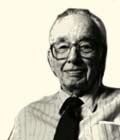
Atanasoff, John Vincent (1903 - 1995)
Born on 4 October 1903 in Hamilton, New York, Atanasoff took a great interest in mathematics from childhood.
At the age of ten, he found his father’s slide rules. He read the instructions and was very interested in the mathematical principles governing their operation. John started to study mathematics using his father’s university textbook with the help of his mother.
In time, the Atanasoff family moved to Old Chicora, Florida, and John went to study at the Mulberry High School, where he graduated in two years
He earned an A grade in all science and mathematics subjects. John did not take the logical next step, which would have been to go to university, because he wanted to earn some money. Finally, he enrolled at Florida University in 1921. He received his BS in Electrical Engineering in 1925, graduating with straight As
He then went to Iowa State College to take a master’s degree. There he met his future wife, Laura Meeks, whom he married a few days after earning his MA in Mathematics in 1926. He then went to the University of Wisconsin to take a PhD in theoretical physics. His first daughter, Elsie, was born in the same year that he was accepted as a PhD student. He earned his PhD in Theoretical Physics in 1930 and went back to Iowa State College as assistant professor of physicsand mathematics.
Atanassoff had always been interested in finding new ways of performing faster mathematical computations. He examined most computing devices at the time, including the Monroe calculator and IBM’s tabulating machines, and concluded that they were slow and inaccurate devices.
After his appointment as associate professor of physics and mathematics, he began to envisage a digital computing machine, because he believed that analog devices were too restrictive and were not precise enough for his purposes. The idea of building an electronic digital computer came to him over a whiskey at an Illinois bar. When he was very overworked, Atanasoff used to drive aimlessly for hours along lonely roads at high speeds. On one of these trips, he stopped at a bar near the frontier with Illinois. As he drank his third whiskey, he had a brilliant idea that was to change the world. Looking at full and empty bottles on the shelves behind the bar, he realized that all calculations could be done in base 2. With only zeros and ones, base 2 is inherently digital, unlike previous computers that worked in base 10. This system was ideally suited to an electronic system that would make or break the electrical circuit. After this revelation, Atanasoff sketched the principles of modern electronic computing on a serviette.
He was joined by Clifford Berry, his student assistant, on the project of building the base 2 computer. In December 1939, they launched the prototype of the first digital computer in history, the Atanasoff Berry Computer or ABC.
In 1940, Atanasoff attended a lecture by John W. Mauchly. Mauchly and Atanasoff had a talk, and Mauchly was very intrigued by the ABC. Mauchly wanted to see the ABC, and Atanasoff agreed. Mauchly used many of the ideas behind ABC to build his computer, the famous ENIAC, which was for many years considered the world’s first electronic digital computer. Finally, after a 1972 court case, it was established that Atanasoff was the legitimate father.
John Vincent Atanasoff died of a stroke on 15 June 1995, aged 91 years, at his home in Monrovia, Maryland.
